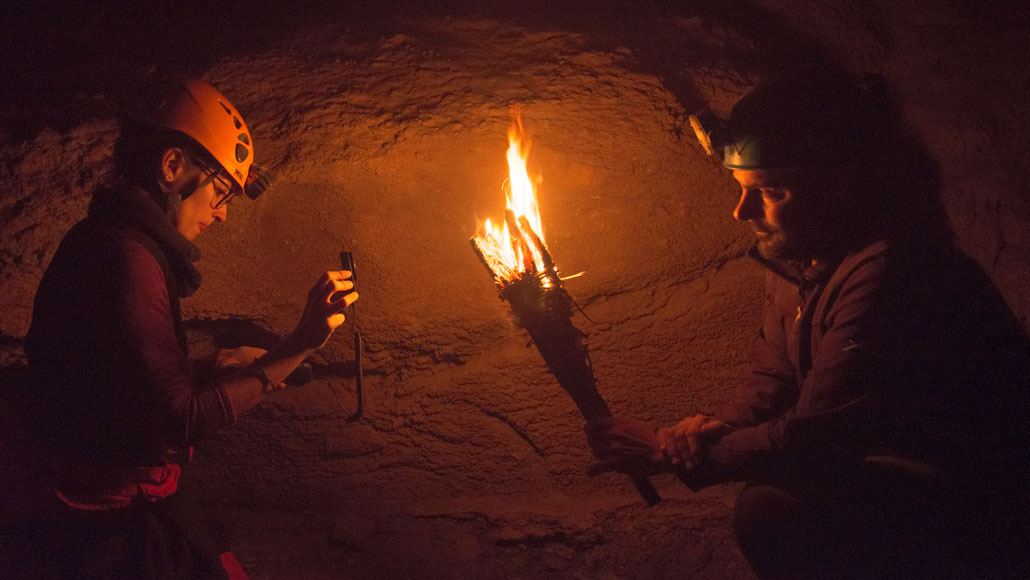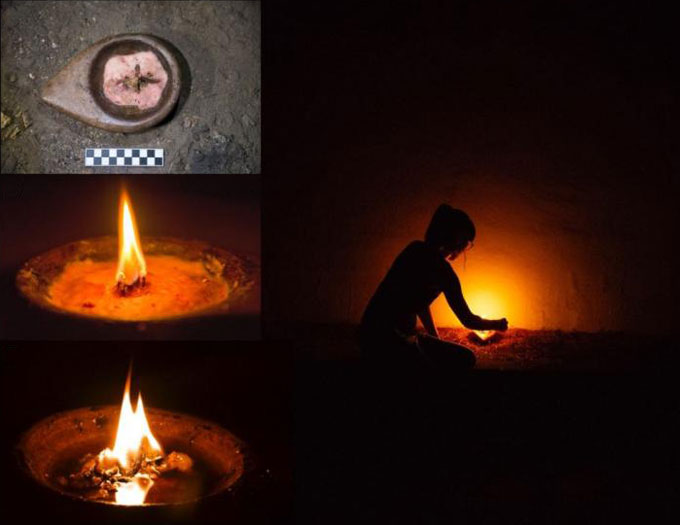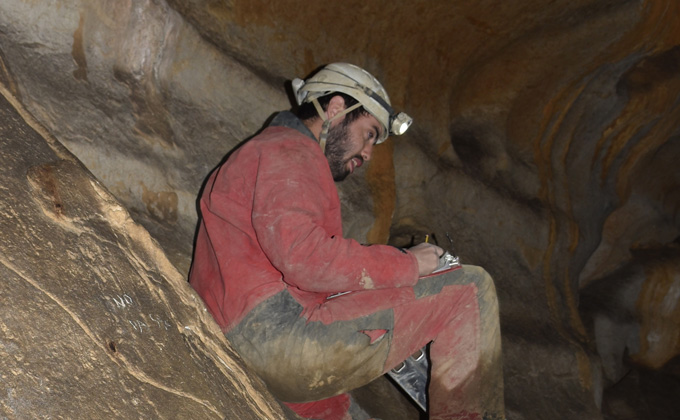How torchlight, lamps and fire illuminated Stone Age cave art
Experiments with ancient light sources show how people created underground paintings

Researchers observe how a torch made of materials available in the Stone Age burns in a cave. Such experiments are helping the researchers understand how humans living thousands of years ago made cave art deep underground.
I. Intxaurbe
As a geologist who studies Stone Age cave art, Iñaki Intxaurbe is used to making treks underground in a headlamp and boots. But the first time he navigated a cave the way humans thousands of years ago would have — barefoot while holding a torch — he learned two things. “The first sensation is that the ground is very wet and cold,” he says. The second: If something chases you, it will be hard to run. “You are not going to see what is in front of you,” he notes.
Torches are just one of several light sources Stone Age artists used to navigate caves. Intxaurbe works at the University of the Basque Country in Leioa, Spain. He and his colleagues have begun wielding fiery tools in dark, damp and often cramped caves. They want to understand how and why humans journeyed underground. And they’d like to know why those long-ago humans created art there.
The researchers trekked into the wide chambers and narrow passageways of Isuntza I Cave. It’s in northern Spain’s Basque region. There, they tested torches, stone lamps and fireplaces (nooks in cave walls). Fueling their light sources were juniper branches, animal fat and other materials that Stone Age humans would have had at hand. The team measured flame intensity and duration. They also measured how far away these light sources could be and still illuminate the walls.

Each light source comes with its own quirks that make it well suited to specific cave spaces and tasks. The team shared what it learned June 16 in PLOS ONE. Stone Age humans would have controlled fire in varying ways, the researchers say — not only to travel through caves but also to make and view art.
Find the light
Three types of light could have lit a cave: a torch, a stone lamp or a fireplace. Each has its own benefits and downsides.
Torches work best on the move. Their flames need motion to stay lit, and they produce a lot of smoke. Though torches cast a wide glow, they burn for an average of just 41 minutes, the team found. That suggests several torches would have been needed to travel through caves.
Concave stone lamps filled with animal fat, on the other hand, are smokeless. They can offer more than an hour of focused, candlelike light. That would have made it easy to stay in one spot for a while.
Fireplaces produce a lot of light. But they can also produce a lot of smoke. That type of light source is best suited for large spaces that get plenty of airflow, the researchers say.
For Intxaurbe, the experiments confirmed what he has seen himself at Atxurra cave. In a narrow passageway there, Stone Age people had used stone lamps. But near high ceilings where smoke can rise, they left signs of fireplaces and torches. “They were very intelligent. They use the better choice for different scenarios,” he says.

The findings reveal a lot about how Stone Age people used light to navigate caves. They also shed light on 12,500-year-old art that Intxaurbe helped discover deep in the Atxurra cave in 2015. Stone Age artists painted about 50 images of horses, goats and bison on a wall. That wall is accessible only by climbing up a roughly 7-meter (23-foot) tall ledge. “The paintings are in a very common cave, but in very uncommon places of the cave,” Intxaurbe says. That may partly explain why previous explorers had failed to notice the art.
A lack of the right lighting also played a part, Intxaurbe and colleagues say. The team simulated how torches, lamps and fireplaces lit up a virtual 3-D model of Atxurra. That let the researchers see the cave’s art with fresh eyes. Using just a torch or a lamp from below, the paintings and engravings stay hidden. But lit fireplaces on the ledge illuminate the whole gallery so that anyone on the cave floor can see it. That suggests the artists may have wanted to keep their work hidden, the researchers say.
Cave art wouldn’t exist without harnessing fire. So to unravel the mysteries of this underground art, it’s key to understand how prehistoric artists lit their surroundings. “Answering the small questions in an accurate way,” Intxaurbe says, is a path toward answering a main question about Stone Age people, “why they painted these things.”







